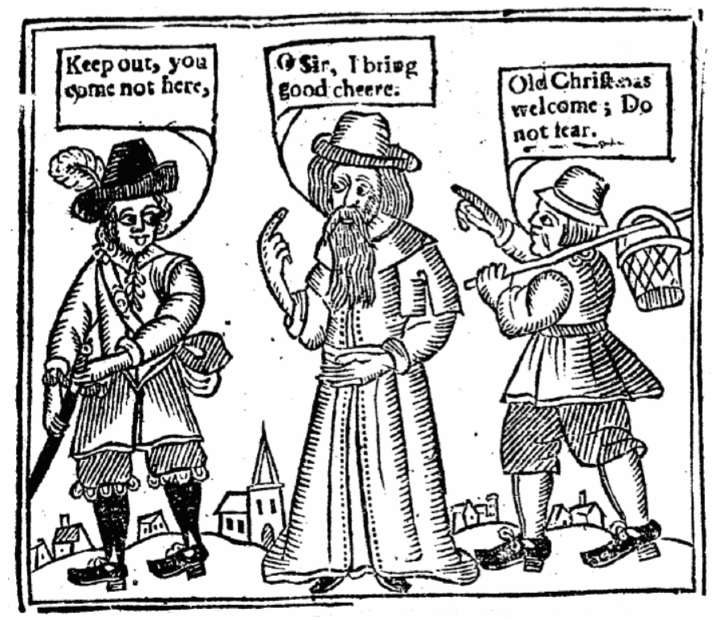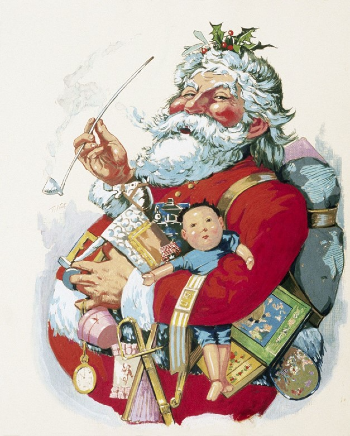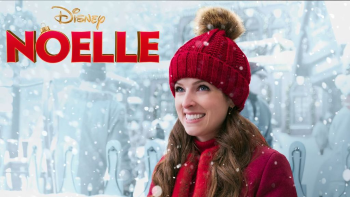The origin and evolution of Father Christmas
Posted on 16 December 2021

John Taylor’s 1652 pamphlet The Vindication of Christmas or, His Twelve Yeares’ Observations upon the Times
Kirsty O'Rourke, MA Public History 2021/22
So, Father Christmas, Santa Claus, St Nicholas, Baba Noel. A man of many names, but who is he? I fear that that answer would take me a while, therefore I am going to narrow the question and focus on Father Christmas and his arrival in the United Kingdom. The man we think of now is a jolly old fellow, with a big round belly, a red suit with white trim, flying in the sky in a sleigh led by nine reindeer bellowing a ‘ho ho ho’. However, this has not always been the Father Christmas depicted in popular culture. Would it surprise you if I told you that he used to be a slim figure that had no reindeer? Probably not. But it might surprise you that early images of Father Christmas have him as a shaman-like character carrying a broom which suggests he encouraged ‘sexual freedom’. That he was more related to the Pagan ‘Lord of Misrule’ rather than the, often thought of, origin story of St Nicholas. It may even surprise you to find out that there is evidence of people believing in a ‘Mother Christmas’.
First, let’s start with a quick overview of St Nicholas. Father Christmas is often linked immediately to him. A well-known story of his is how he helped a father living in poverty from selling his three daughters into prostitution by providing them with money for a dowry. He became known as the protector of children. A less well-known story is that as a baby he would only breastfeed on Wednesdays and Fridays, how that hasn’t leaked into the story of Father Christmas I’ll never know. Anyway, his day, the 6th December, is the anniversary of his death and is when he is celebrated. While, in the present day, this story is usually used as the origin story of the British Father Christmas, it appears that our Father Christmas may have originated from a different story.
To start with, we do not tend to celebrate the 6th of December in Britain, unlike the Netherlands, Belgium or Luxembourg. We instead focus on the 25th of December and even the 12 days of Christmas. In much of the historical sources, St Nicholas is often seen as another character in the Christmas story alongside Father Christmas. Our Father Christmas, possibly the Lord of Misrule, presided over festive parties, feasts and drinking. He was symbolic of the season rather than an actual being. Christmas was focused more on entertainment for adults rather than a time for children. He has been argued as originating from a Pagan Shaman-like figure who predates St Nicholas.
So, our Father Christmas may have been quite the partier. How did we then go from this stereotypical bachelor seen in Hollywood films, to a jolly old man with an army of elves? There are a few different ways through the help of ‘public history’ – theatres, songs, and stories telling the history of Father Christmas – that he was evolved. In 1616, a playwright called Ben Johnson wrote Christmas, His Masque in which the character of ‘Christmas’ is called ‘Old Christmas’. He looks characteristically old with a long white beard and old-style clothing. He is depicted as an actual father in this play – his children have names such as ‘Misrule’, ‘Carol’ and ‘Wassail’. Or, my favourite, and if I were to ever have kids this would be their name, ‘Mince Pie’. This ‘Old Christmas’ is starting to bring multiple Christmas stories together.

Colour version of Thomas Nast’s ‘Merry Old Santa Claus’, Harper’s Weekly, 1 Jan 1881
However, over the next couple of hundred years, Father Christmas is still seen as someone who enjoys feasts and parties. He is depicted in plays and folktales as someone obsessed with fun. Still not quite the jolly old man who delivers presents. That does not seem to cement itself into the public’s imagination until the Victorian period. There was a lot of change happening at this time, including more of a focus on family life. Children were no longer seen as strange tiny adults, instead, they were seen as strange tiny children. A figure was needed – maybe one of a jolly old man. As I write this, I have to admit it does sound strange to choose an old man who watches children when they’re sleeping, but that is a rabbit hole I refuse to go down.
To understand our image of Father Christmas we have to first look to the United States of America. They have another history of how Santa reached their shores, but my word count is already looking far too high for a casual read. So, the USA had a version of Santa and in the 19th century, he began to evolve based on old Dutch traditions. Through historians such as Washington Irving and poems such as ‘Sancte Claus’, ‘Old Santeclaus with Much Delight, and ‘A Visit from St Nicholas’ – otherwise known as ‘The Night Before Christmas’ – the Father Christmas we know today starts to be formed. Chimneys, reindeer, his red coat and even Christmas Eve are mentioned in these poems.
However, poems can only do so much. It seems that the illustrations that accompanied them had more of an impact on the public imagination. Thomas Nast, an American cartoonist, through illustrations for ‘A Visit from St Nicholas’ and his cartoon ‘Merry Old Santa Claus’, introduced the North Pole and Santa’s workshop and finalised the Father Christmas we know today. There was a seemingly strange merge of Santa Claus and Father Christmas in Britain, at one point they appeared in a story together. But, by the 1880s the imagery of the American Santa Claus was now in the public imagination of who Father Christmas was. He was a popular figure in Victorian Christmases which became a time for children and charity.
Well. There we have it. A very brief origin story of our Father Christmas. Never to be changed again. Or is it? Commercialisation has an impact on how we see Father Christmas and Christmas traditions, and how they evolve. But, also, as I previously mentioned, the public history of Father Christmas has constantly impacted his look and role so what stops it from changing today? Folklore, poetry and songs did a lot to create his image. So, what about films? From films such as The Santa Clause, Klaus, Noelle, and The Christmas Chronicles 2, we continually explore the origin of Father Christmas and how he, or she, can ‘live forever’. Many are magical, some are cynical and most try to deliver a message of Christmas. One of love, selflessness, gratitude, and togetherness.

Anna Kendrick as Noelle – the new Santa, in Noelle (2019) dir. by Marc Lawrence. Source: https://www.disneyplus.com/en-gb/movies/noelle/1NOwi3epkH6X
Times are changing and Father Christmas appears to be getting a new look. He is still generally thought of as the jolly, round old man who delivers presents. But now, we’re not just exploring his origins we’re also attempting to explain him in the present. We show him as being capable of being anyone – I mean, The Santa Clause shows that you just have to murder him to become him. And films such as Noelle, Mrs Santa Claus, Santa Baby and Santa Girl all explore a woman, either wife or daughter, taking over the family business and becoming Santa. Shock horror. He’s called Father Christmas, not Mother Christmas. What’s next? Equal pay?
I’m genuinely excited to see how he might evolve. With films attempting to explain how he can ‘live forever’ through it being a family business, I’m looking forward to seeing more Mother Christmases. The Christmas ‘vibe’ of giving, presents, selflessness and love overcoming hate I hope continues in songs, stories, and popular imagination. But the character of ‘Father Christmas’? I cannot wait to see what happens and who he might be in fifty years.
As always, my blogs are not able to cover everything. Things have been missed and other arguments on the origins of Father Christmas have not totally seen the light. Therefore, below is a list of readings where you can find other, more in-depth analyses of the figure of Father Christmas and the sources I used to come to my conclusions. See if you come to the same conclusions!
Further reading:
‘Father Christmas and Santa Claus: a brief history of two Christmas champions’. BBC History Extra. https://www.historyextra.com/period/stuart/father-christmas-santa-claus-history-how-old-reindeer-coca-cola-sinterklaas-kris-kringle/
Harding, Patrick. The Christmas Book. London: Metro Publishing Ltd, 2007.
‘History of Christmas’. Christmas 2021. English Heritage. https://www.english-heritage.org.uk/christmas/the-history-of-christmas/
‘History of Christmas’. Sky History. https://www.history.com/topics/christmas/history-of-christmas
Moriarty, Tom. ‘The History of Father Christmas’. English Heritage. https://www.english-heritage.org.uk/christmas/the-history-of-father-christmas/
‘The strange film history of Santa’. BBC Culture. https://www.bbc.com/culture/article/20161220-the-strange-film-history-of-santa
Podcasts on Christmas:
Daybell, James and Sam Willis. Histories of the Unexpected. Podcast audio. https://historiesoftheunexpected.com/
Jenner, Greg. ‘The Victorian Christmas’. You’re Dead To Me. Podcast audio. https://www.bbc.co.uk/programmes/p07xl3bm
‘The history of Christmas: everything you wanted to know’. BBC History Extra. Podcast audio. 20 December 2020. https://www.historyextra.com/period/stuart/history-christmas-george-goodwin-everything-you-wanted-know-podcast/
Follow Kirsty on Twitter @KirstyMORourke and visit her blog Existential Historian for more content.
